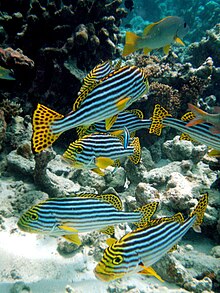Indian Ocean oriental sweetlips
| Indian Ocean oriental sweetlips | |
|---|---|

| |
| Scientific classification | |
| Domain: | Eukaryota |
| Kingdom: | Animalia |
| Phylum: | Chordata |
| Class: | Actinopterygii |
| Order: | Perciformes |
| Family: | Haemulidae |
| Genus: | Plectorhinchus |
| Species: | P. vittatus
|
| Binomial name | |
| Plectorhinchus vittatus | |
| Synonyms[2] | |
| |
The Indian Ocean oriental sweetlips (Plectorhinchus vittatus), also known as the oriental sweetlips or oriental blubberlips, is a
Description
The Indian Ocean oriental sweetlips has fleshy lips which become greatly swollen as the fish ages. There are 6 pores on its chin but there is no median pit.
Distribution
The Indian Ocean oriental sweetlips is found in the Indo-Pacific region. Its range extends from East Africa from Djibouti to South Africa, Madagascar, the Seychelles and Mascarene Islands, the Gulf of Mannar in India and the Andaman and Nicobar Islands east to Micronesia, Samoa, the Society Islands and Guam. It can alsdo be found from Western Australia to Papua New Guinea and New Caledonia.[1]
Habitat and biology
The Indian Ocean oriental sweetlips inhabits shallow, coastal coral reefs, lagoons and seaward reefs at depths of 2 to 25 m (6 ft 7 in to 82 ft 0 in). It is found singly or in small aggregations and is tends to be nocturnal. The juveniles may be found in tidepools and in beds of
Systematics
The Indian Ocean oriental sweetlips was first formally
Utilisation
The Indian Ocean oriental sweetlips is caught by fisheries in much of its range, and is caught using hand nets and by
References
- ^ . Retrieved 19 November 2021.
- ^ a b c d Froese, Rainer; Pauly, Daniel (eds.) (2021). "Plectorhinchus vittatus" in FishBase. February 2021 version.
- ^ a b c R.J. MacKay (2001). "Haemulidae". In Carpenter, K.E. & Neim, Volker H. (eds.). The Living Marine Resources of the Western Central Pacific Volume 5: Bony fishes part 3 (Menidae to Pomacentridae) (PDF). FAO Species Identification Guide for Fishery Purposes. FAO Rome. p. 2979.
- ^ Dianne J. Bray. "Plectorhinchus vittatus". Fishes of Australia. Museums Victoria. Retrieved 2 May 2021.
- ^ a b "Plectorhinchus vittatus". Saltcorner!. Bob Goemans. 2012. Retrieved 2 May 2021.
- ^ Eschmeyer, William N.; Fricke, Ron & van der Laan, Richard (eds.). "Species in the genus Plectorhinchus". Catalog of Fishes. California Academy of Sciences. Retrieved 2 May 2021.
- ^ Christopher Scharpf & Kenneth J. Lazara, eds. (5 January 2021). "Order LUTJANIFORMES: Families HAEMULIDAE and LUTJANIDAE". The ETYFish Project Fish Name Etymology Database. Christopher Scharpf and Kenneth J. Lazara. Retrieved 2 May 2021.
- Photos of Indian Ocean oriental sweetlips on Sealife Collection

